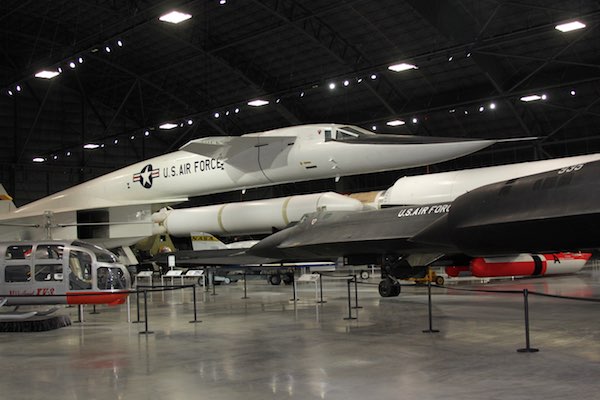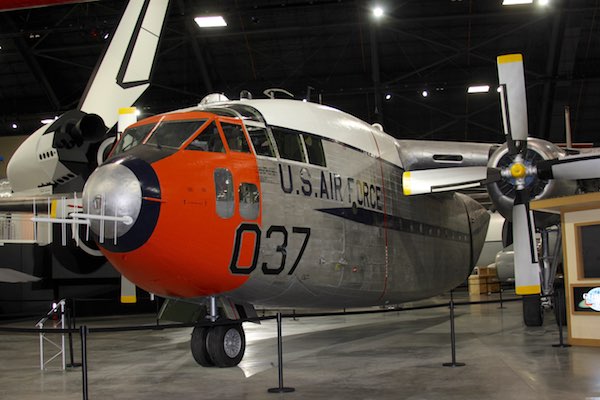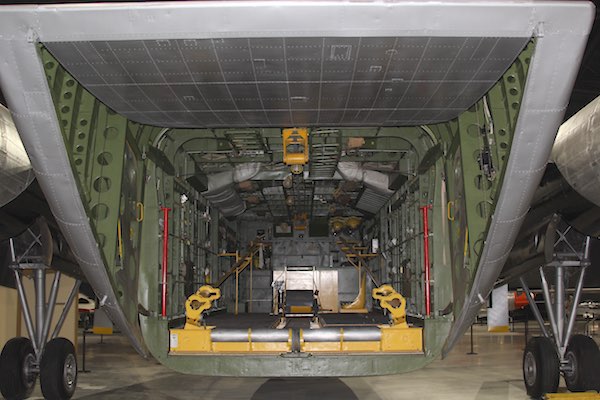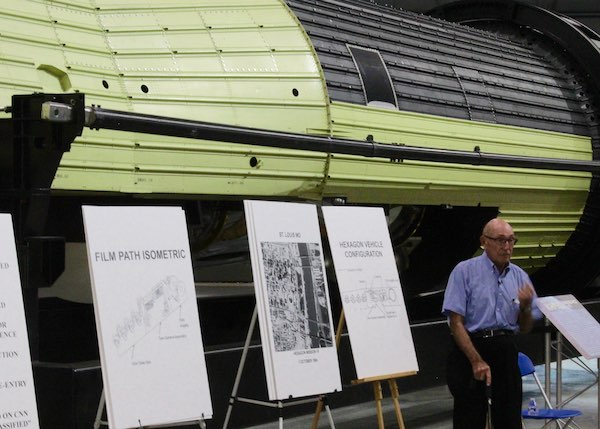
The Air Force Museum’s impressive encoreby Dwayne Day
|
| One of the surprises was that the building is well lit, which should not be surprising in a museum. Unfortunately, the Air Force Museum’s other buildings are dark. |
Most of the aircraft and spacecraft in this building have previously been displayed at the museum, either outdoors or in a couple of annex buildings on the adjacent Air Force base. But they now have the home they deserve. Currently spacious, it is possible that one day it may be filled with even more aircraft. But for now it has enough room to allow visitors to stand back from some of the larger aircraft and see them in their entirety, unobstructed.
One of the surprises was that the building is well lit, which should not be surprising in a museum. Unfortunately, the Air Force Museum’s other buildings are dark. That makes photography difficult, requiring a tripod and some skill. But a friend of mine noted that he even has trouble reading the signs in the other buildings, undercutting the museum’s mission of educating the visitors. The fourth building is fairly bright, which was practically a requirement considering the artifacts it holds.
 An XB-70 Valkyrie (left) on display in the museum’ new building. (credit: D. Day) |
Previously two major aircraft collections were kept over on the Air Force base and accessible only via bus—before visits were prohibited due to new security restrictions. The presidential aircraft and research and development aircraft collections were crammed into small hangars on the base. In the case of the R&D aircraft, this created a weird situation whereby you had to walk around and even under the aircraft. Visitors were admonished not to touch the aircraft, advice that was a little difficult to follow when standing right next to one of only two X-15s still in existence, or next to the tires of the iconic XB-70 Valkyrie.
Although they’re not among my personal favorites, the gems in the collection in the new building are the presidential aircraft that carried around presidents starting with Franklin Roosevelt. Many are highly polished, probably the reason that the lights are turned up in the new building. They shine. The Air Force One Boeing 707 that carried John F. Kennedy’s casket back to Washington is stunning. Eisenhower’s Lockheed Constellation Columbine III is also a sight. In addition, the interiors of the aircraft have been cleaned up and fitted with new plexiglass protective screens. They look incredible, like they could be fueled up and take flight again.
| But the open door revealed the aircraft’s secret. You see, this C-119 is the first aircraft to ever catch an object that returned from space. |
The two big surprises for me were, not surprisingly, space-related. One was the Titan IVB rocket that was previously in storage and is now displayed at one end of the building. It wasn’t the rocket itself that impressed me as much as its two solid rocket motors. You can stand at the tail of the rocket and see the Titan core’s two liquid rocket engines that are dwarfed by the giant black exhaust throats of the solid motors. The view alone provides a good sense of just how powerful those motors were.
 The C-119 cargo plane on display at the museum looks ordinary from the outside… (credit: D. Day) |
The other surprise was an orange and white C-119 cargo plane. The aircraft used to be referred to as the Flying Boxcar because of its shape. It is not a pretty airplane. It is also not new, having been displayed outside the museum on the flight line for several decades. The last time I saw the plane it looked like it had not been doing well in the Ohio weather. Now it is gleaming and fresh, with new cockpit windows. But the real surprise was that the rear cargo door was open, revealing the C-119’s mission hardware.
In all the years that I’ve seen this C-119 at the museum it never occurred to me that it might still have something inside. I assumed it was just an empty cargo hold. But the open door revealed the aircraft’s secret. You see, this C-119 is the first aircraft to ever catch an object that returned from space. Discoverer 13 was the first object successfully returned from space, landing in the Pacific Ocean in August 1960. Discoverer 13’s capsule, which is now on display in the Milestones of Flight Gallery in the Smithsonian’s National Air and Space Museum in Washington, DC, contained a flag and little else. It was not supposed to reach the water, but a problem during the recovery effort allowed that to happen and the capsule was recovered by a tracking ship.
The Air Force did not make the same mistake a short time later with Discoverer 14. It was snagged out of the air by the C-119 now on display in the Air Force Museum. Discoverer 14 was actually a cover name and a cover story. The capsule contained something much more important than a flag during its descent—it carried exposed reconnaissance film from the first successful CORONA reconnaissance mission.
 …but inside reveals the telescoping rods used to capture CORONA film capsules. (credit: D. Day) |
The device used to capture the Discoverer 14 capsule was a special cable system. Two long aluminum poles were extended out of the back of the C-119 and cantered outward. Between them ran a cable equipped with hooks. The pilot lined up on the space capsule descending on its parachute and by timing it just right he could fly over the parachute at exactly the right speed, altitude and angle and capture the parachute above the cable and snag its lines with the cable hooks. The cable would reel out behind the airplane on a winch and a sergeant standing in the back of the cargo bay would apply a tension brake to slow down the cable.
According to one of the original officers running the satellite program during its early development in the late 1950s, whenever they briefed senior officers they would talk about the spacecraft operating in vacuum and extreme temperature swings and doing all of this robotically and they would not get any objections. But as soon as they mentioned the capture technique somebody—a pilot—would object and say that it was not possible to catch a descending space capsule. They didn’t object to the difficult things they did not understand, but they knew flying, and they knew this could not be done. It always fell to the briefer to explain that the technique had already been demonstrated numerous times with payloads dropped from high altitude balloons.
That recovery equipment in the C-119 is visible, although the interior of the aircraft is not lighted, nor is there any signage explaining its operation or showing what it did. That may come later. What is amazing is that it was preserved and it is finally on display.
There are other space-related artifacts nearby. The Apollo 15 spacecraft is near the entrance to the building. Nearby is an X-15, a Mercury spacecraft and the Gemini B spacecraft. This Gemini B was a test craft that demonstrated that the spacecraft could reenter the atmosphere even though there was a hatch cut into its heat shield for astronauts to crawl through to access the Manned Orbiting Laboratory operations module.
Alongside the Titan IVB are one of two remaining KH-7 GAMBIT-1 reconnaissance spacecraft that operated in the mid-1960s (the other is in the Smithsonian) and a mockup of the KH-8 GAMBIT-3 reconnaissance spacecraft that operated until the 1980s. Opposite these two formerly top secret spacecraft is the KH-9 HEXAGON, and that’s where Phil Pressel was on the day that I visited.
 Phil Pressel discusses the HEXAGON camera system he worked on a half-century ago. (credit: D. Day) |
Pressel designed the HEXAGON’s camera system along with about a thousand other people involved in the CIA program that started in the mid-1960s. The HEXAGON is as big as a bus, and it was designed to photograph vast swaths of territory on film that moved through its two cameras at high rates of speed. Each image covered hundreds, if not thousands, of square kilometers at resolution significantly better than one meter. This made the HEXAGON a powerful intelligence tool because it could, for instance, photograph several Soviet aircraft bases at once, enabling analysts to develop highly accurate counts of the numbers of airplanes they contained.
| Pressel told a story about how one time, when a HEXAGON satellite was mounted vertically in a high bay, he was leaning inside the vehicle performing some work when he dropped a C-clamp inside of it. He didn’t tell his boss until 2011, when the program was finally declassified. |
Pressel gave four one-hour talks in front of the HEXAGON during the day, discussing the design of the system and the problems they encountered in development. (One of the talks was video recorded and should be available on the Internet soon.) Pressel explained that the first HEXAGON was launched in 1971 and the last one was destroyed in 1986 when its Titan 34D rocket—similar to the Titan IVB looming nearby—blew up just above its launch pad. He explained how the HEXAGON’s big film return capsules were grabbed out of the air by a C-130 aircraft that was the successor to the C-119 that caught Discoverer 14.
Pressel told a story about how one time, when a HEXAGON satellite was mounted vertically in a high bay at Lockheed Missiles and Space Company in California, he was leaning inside the vehicle performing some work when he dropped a C-clamp inside of it. He heard it fall three meters to the bottom, below the delicate optics. He and a technician got a piece of string and a magnet and fished for the errant tool, carefully pulling it up and out, and then swearing to never tell anybody about what had happened. Pressel didn’t tell his boss until 2011, when the program was finally declassified.
The new building is outstanding and well worth a trip to Dayton. Hopefully the museum will add some more signage to help provide context explaining the artifacts. But for now it’s enough to wander among the amazing craft and marvel at the fantastic engineering work that went into designing them.